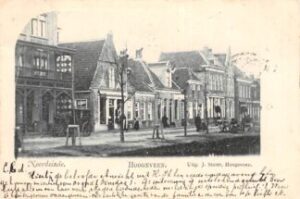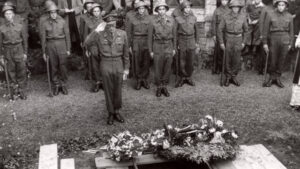Slomp, Fredrik, “Frits” born 05-03-1898 Ruinerwold  as the farmer’s son of Jan Slomp and Grietje born Zantinge. Frits married on 26-10-1926 to Tjaltje, born ten Kate (1896-1988).
as the farmer’s son of Jan Slomp and Grietje born Zantinge. Frits married on 26-10-1926 to Tjaltje, born ten Kate (1896-1988).  From this marriage one son and one daughter were born. Frits Slomp grew up as the second of three sons in a reformed family in Drenthe that was closely involved with church and society. Following their father, all three brothers initially wanted to become farmers, but in 1914 Frits decided to study theology ‘to wake people up’ (Trouw, 6-2-1952). Frits therefore went to live in Kampen, where he attended the reformed grammar school, which was closely linked to the Theological School. The young Slomp tried to make up for the time he lost fulfilling his military service from June 1918 to March 1919 by taking the state exam after his return in 1920. However, he failed this, as well as the entrance exam for the theological faculty of the Free University of Amsterdam.
From this marriage one son and one daughter were born. Frits Slomp grew up as the second of three sons in a reformed family in Drenthe that was closely involved with church and society. Following their father, all three brothers initially wanted to become farmers, but in 1914 Frits decided to study theology ‘to wake people up’ (Trouw, 6-2-1952). Frits therefore went to live in Kampen, where he attended the reformed grammar school, which was closely linked to the Theological School. The young Slomp tried to make up for the time he lost fulfilling his military service from June 1918 to March 1919 by taking the state exam after his return in 1920. However, he failed this, as well as the entrance exam for the theological faculty of the Free University of Amsterdam.  Instead, Slomp was admitted to the Theological School in Kampen with a dispensation in 1921. He graduated there on 27-09-1926. A month later he married Tjaltje ten Kate, the eldest daughter of a local headmaster, whom he had met in his first boarding house. In 1929 and 1932 respectively a daughter and a son would be born from this marriage.
Instead, Slomp was admitted to the Theological School in Kampen with a dispensation in 1921. He graduated there on 27-09-1926. A month later he married Tjaltje ten Kate, the eldest daughter of a local headmaster, whom he had met in his first boarding house. In 1929 and 1932 respectively a daughter and a son would be born from this marriage.
Early in 1927, Slomp became the first reformed minister in Nieuwlande in South Drenthe. Three years later, Heemse near Hardenberg in Overijssel became his new congregation. Because this place was close to the border, Germans were also among his churchgoers. They kept him informed of the political developments in their country. By subscribing to six national socialist magazines early on and reading the works of Adolf Hitler and Alfred Rosenberg, 
 the ideologist of the Nazi party, he understood the dangers of the national socialist concept of the state. In addition, German parishioners asked Slomp for advice from the start. Although his church council and his wife, influenced by her parents, were not always happy with this, he warned his own parishioners and catechists against the dangers of national socialism. Slomp did the same when he led the Alt Reformierte Kirche in Bentheim
the ideologist of the Nazi party, he understood the dangers of the national socialist concept of the state. In addition, German parishioners asked Slomp for advice from the start. Although his church council and his wife, influenced by her parents, were not always happy with this, he warned his own parishioners and catechists against the dangers of national socialism. Slomp did the same when he led the Alt Reformierte Kirche in Bentheim  and East Friesland or when he gave lectures there. After Germany imposed a ban on Dutch preachers in 1937, he continued to do so during well-attended ‘hedge sermons’.
and East Friesland or when he gave lectures there. After Germany imposed a ban on Dutch preachers in 1937, he continued to do so during well-attended ‘hedge sermons’.
Slomp helped German Jews who increasingly crossed the Dutch border illegally after the Reichskristallnacht 
 of November 1938 to find shelter. He also found a hiding place for Reich Germans from Heemse who refused to perform their military service in the Wehrmacht in 1941. Slomp was not anti-German, but anti-Nazi. In addition, during the occupation he called for resistance against the occupier in many ways, including at illegal meetings of the Anti-Revolutionary Party (ARP)
of November 1938 to find shelter. He also found a hiding place for Reich Germans from Heemse who refused to perform their military service in the Wehrmacht in 1941. Slomp was not anti-German, but anti-Nazi. In addition, during the occupation he called for resistance against the occupier in many ways, including at illegal meetings of the Anti-Revolutionary Party (ARP)  and the Christian National Trade Union,
and the Christian National Trade Union,  which were banned by the Germans. After Slomp had called on churchgoers during a sermon in Zwolle on 12-07-1942 to sabotage the work of the Labour Service
which were banned by the Germans. After Slomp had called on churchgoers during a sermon in Zwolle on 12-07-1942 to sabotage the work of the Labour Service  as a matter of Christian duty, the Gestapo
as a matter of Christian duty, the Gestapo  wanted to arrest him. Thanks to a timely warning, he managed to escape this and had to go into hiding.
wanted to arrest him. Thanks to a timely warning, he managed to escape this and had to go into hiding.
Slomp was still in hiding at the end of November 1942 when, after a lecture in Winterswijk, he got to know Helena Kuipers-Rietberg, 
 a board member of the Association of Reformed Women’s Associations, better. Under the resistance name ‘Tante Riek’, she and her husband helped people in hiding, and at her urgent request Slomp started to set up a national network: the National Organisation for Assistance to People in Hiding (LO). The National Organisation for Assistance to People in Hiding (LO) and the National Resistance Groups (LKP) are the largest Dutch resistance organisations from 1942 onwards. The Christian LO helps many people in hiding during the war, as do other resistance groups that help people in hiding. In August 1943, the National Organisation for Aid to Those in Hiding (LO) began setting up a network of Landelijke Knokploegen [LKP, National Organisation of Armed Squads].
a board member of the Association of Reformed Women’s Associations, better. Under the resistance name ‘Tante Riek’, she and her husband helped people in hiding, and at her urgent request Slomp started to set up a national network: the National Organisation for Assistance to People in Hiding (LO). The National Organisation for Assistance to People in Hiding (LO) and the National Resistance Groups (LKP) are the largest Dutch resistance organisations from 1942 onwards. The Christian LO helps many people in hiding during the war, as do other resistance groups that help people in hiding. In August 1943, the National Organisation for Aid to Those in Hiding (LO) began setting up a network of Landelijke Knokploegen [LKP, National Organisation of Armed Squads].  The armed squads set registry offices on fire and carried out armed raids in which they seize ration coupons and blank identity cards.
The armed squads set registry offices on fire and carried out armed raids in which they seize ration coupons and blank identity cards.
Slomp travelled throughout the country – one of his aliases was ‘Frits de Zwerver’ – to form new committees of ‘Die Organisation Frits’, as the occupier called the then still nameless resistance organisation, in addition to existing groups. Now he visited acquaintances, then again he preached somewhere unannounced or gave a lecture as ‘Elder Van Zanten from Dordrecht’. Although he made little impression at first sight because of his small stature, he had great persuasiveness, which arose from his principled philosophy of life. In this he was helped by his knowledge of people and empathy, as well as his spontaneity, sensitivity, boldness and independence.
With his self-will and recklessness, Slomp sometimes drove those close to him to despair. After narrowly escaping arrest earlier, he was accidentally arrested by two military police officers in Ruurlo on 01-05-1944 – they mistook him for a Jew – and taken to prison in Arnhem. But before he could be transported to prison in Scheveningen, friends from the Landelijke Knokploegen (LKP) managed to free him. After that, he and his family went into hiding until the end of the occupation.
After the liberation of Overijssel on 11-04-1945, Slomp was charged with the public authority in Hardenberg for a few weeks during the transition period, at the request of the deposed mayor. Slomp then went to the western Netherlands as a non-commissioned officer in the Canadian army  to make contact with members of the resistance. Because the church council of Heemse gave him a year’s exemption, he was able – within the context of the LO and the LKP – to devote all his attention to caring for the widows and orphans of the approximately 1,700 members of the resistance who had died during the German occupation.
to make contact with members of the resistance. Because the church council of Heemse gave him a year’s exemption, he was able – within the context of the LO and the LKP – to devote all his attention to caring for the widows and orphans of the approximately 1,700 members of the resistance who had died during the German occupation.
The rest of Slomp’s life would be determined by his war experiences. At the request of the leadership of the LO and LKP, he gave lectures on ‘The spiritual background of the resistance’ all over the country from 15 June 1945 to 6 March 1946, together with a leader from the Roman Catholic resistance – first the Redemptorist Lodewijk Bleijs 
 and then the Dominican Father Victor (Nico Apeldoorn).
and then the Dominican Father Victor (Nico Apeldoorn).  In these lectures he emphasised the indispensable role of women for the resistance, through their dangerous work as a courier, or – in the background – by making it possible to go into hiding in the family and giving moral support to her husband in the resistance. One of them was Slomp’s own wife, who regularly hid people in hiding in the rectory in 1943 and 1944, which also served as a transit house for resistance fighters.
In these lectures he emphasised the indispensable role of women for the resistance, through their dangerous work as a courier, or – in the background – by making it possible to go into hiding in the family and giving moral support to her husband in the resistance. One of them was Slomp’s own wife, who regularly hid people in hiding in the rectory in 1943 and 1944, which also served as a transit house for resistance fighters.
Death and burial ground of Slomp, Fredrik, “Frits”.



Frits later also devoted himself to pastoral care for people who had collaborated with the Germans; this paid off because it resulted in a number of former NSB  members and an SS member repenting and making a confession of faith with him.In the autumn of 1945 he accepted the ministry in Blokker (N-H). He then left for the then Dutch East Indies in 1948 and thus experienced the second police action. In 1949 the jeep he was in hit a landmine; although he was not seriously injured, he did suffer permanent hearing loss.In 1950 he returned to Hoorn; because of evangelism among people from lower income groups he came into conflict with the church council and therefore retired prematurely in 1962. In the town of Wolvega he continued these kinds of evangelism actions until 1966. He then moved to Vaassen. In 1972 he was diagnosed with cancer, from which he eventually died on 13-12-1978, age 80, in Vaassen, at the age of eighty. Slomp is buried in the cemetery of the Reformed Church in Berghuizen. On 18-10-1948 Slomp received the King’s Medal for Courage in the Cause of Freedom from the English government. On his 70th birthday, 05-03-1968, Rev. Slomp received the decorations belonging to the officership of the Order of Orange Nassau from the hands of the mayor of Epe. On 28-04-2014 the Yad Vashem award was posthumously awarded to Slomp and his wife Tjaltje Slomp-Ten Kate. The presentation took place in the Resistance Museum in Amsterdam.
members and an SS member repenting and making a confession of faith with him.In the autumn of 1945 he accepted the ministry in Blokker (N-H). He then left for the then Dutch East Indies in 1948 and thus experienced the second police action. In 1949 the jeep he was in hit a landmine; although he was not seriously injured, he did suffer permanent hearing loss.In 1950 he returned to Hoorn; because of evangelism among people from lower income groups he came into conflict with the church council and therefore retired prematurely in 1962. In the town of Wolvega he continued these kinds of evangelism actions until 1966. He then moved to Vaassen. In 1972 he was diagnosed with cancer, from which he eventually died on 13-12-1978, age 80, in Vaassen, at the age of eighty. Slomp is buried in the cemetery of the Reformed Church in Berghuizen. On 18-10-1948 Slomp received the King’s Medal for Courage in the Cause of Freedom from the English government. On his 70th birthday, 05-03-1968, Rev. Slomp received the decorations belonging to the officership of the Order of Orange Nassau from the hands of the mayor of Epe. On 28-04-2014 the Yad Vashem award was posthumously awarded to Slomp and his wife Tjaltje Slomp-Ten Kate. The presentation took place in the Resistance Museum in Amsterdam.




















Leave a Reply